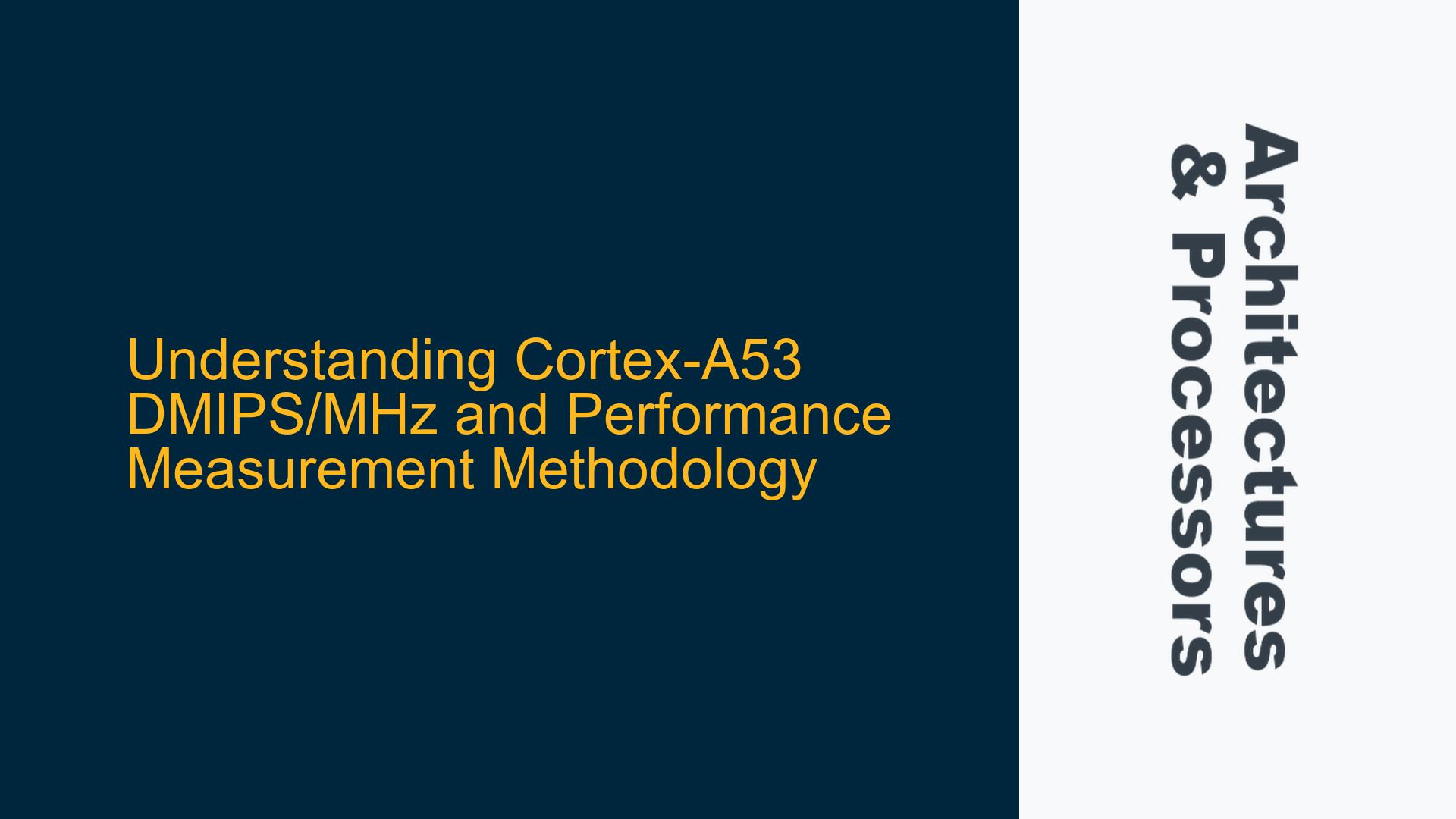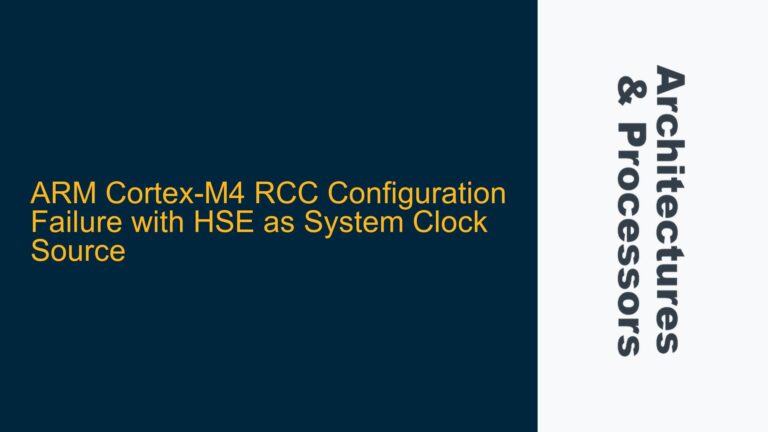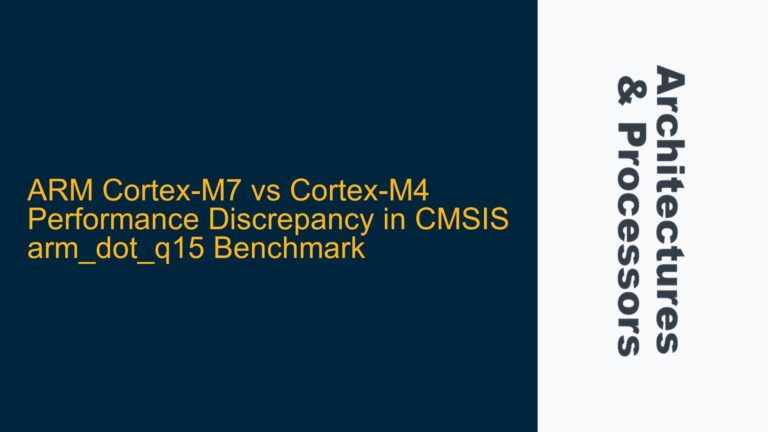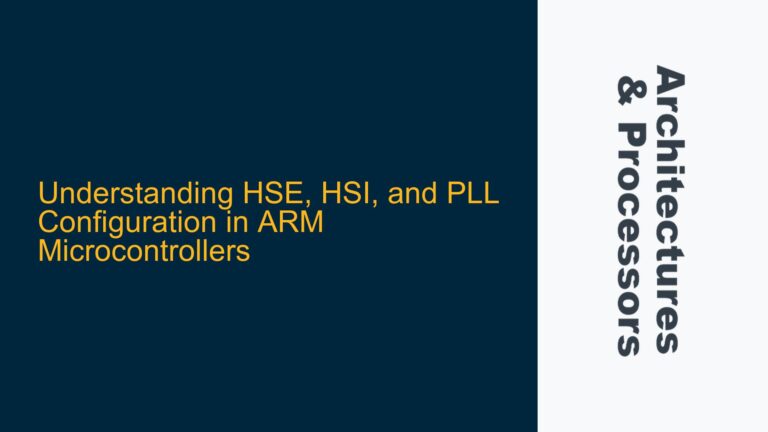Cortex-A53 DMIPS/MHz: Official Documentation and Unofficial Claims
The Cortex-A53 is a highly efficient 64-bit ARM processor core designed for a wide range of applications, from mobile devices to embedded systems. One of the key metrics used to evaluate processor performance is DMIPS/MHz (Dhrystone MIPS per MHz), which provides a standardized measure of a processor’s integer computation capabilities. However, the official ARM documentation for the Cortex-A53 does not explicitly state a DMIPS/MHz value, unlike the Cortex-M7, which clearly lists its DMIPS/MHz on its product page. This absence has led to confusion and reliance on unofficial sources, which often cite a DMIPS/MHz value of around 2.3 for the Cortex-A53.
The Dhrystone benchmark is a synthetic benchmark designed to measure integer performance, and DMIPS/MHz is derived from the Dhrystone score normalized by the processor’s clock speed. While this metric is useful for comparing processors, it is essential to understand the context in which it is measured. Factors such as compiler optimizations, core configurations, and memory subsystem performance can significantly influence the DMIPS/MHz value. The Cortex-A53’s performance is particularly sensitive to these factors due to its in-order execution pipeline and focus on power efficiency.
Unofficial sources, such as Wikipedia and archived ARM web pages, often cite a DMIPS/MHz value of 2.3 for the Cortex-A53. However, these sources do not provide detailed information about the testing conditions, such as the compiler used, optimization level, or core configuration. This lack of transparency makes it difficult to validate the accuracy of these claims or compare them with other processors. Additionally, the Cortex-A53’s performance can vary depending on whether it is operating in a single-core, dual-core, or quad-core configuration, as well as the specific workload being executed.
Compiler Optimization Levels and Core Configuration Impact
The DMIPS/MHz value of the Cortex-A53 is influenced by several factors, including the compiler optimization level and the core configuration. ARM’s official compiler, armcc, offers multiple optimization levels, ranging from -O0 (no optimization) to -O3 (high optimization). Higher optimization levels can significantly improve performance by enabling advanced techniques such as loop unrolling, instruction scheduling, and function inlining. However, these optimizations can also increase code size and potentially introduce subtle bugs, making it essential to carefully select the appropriate optimization level for a given application.
The Cortex-A53’s in-order execution pipeline means that it relies heavily on compiler optimizations to achieve high performance. Without aggressive optimizations, the processor may not fully utilize its execution units, leading to lower DMIPS/MHz values. For example, a Cortex-A53 core running code compiled with -O0 may achieve a DMIPS/MHz value significantly lower than 2.3, while the same core running code compiled with -O3 may achieve a value closer to the unofficial claims.
Core configuration also plays a critical role in determining the Cortex-A53’s DMIPS/MHz value. The Cortex-A53 is often used in multi-core configurations, such as dual-core or quad-core setups. In these configurations, the performance of each core can be affected by factors such as cache coherency, memory bandwidth, and inter-core communication. For example, a quad-core Cortex-A53 configuration may achieve a lower per-core DMIPS/MHz value compared to a single-core configuration due to increased contention for shared resources. Additionally, the Cortex-A53’s performance can vary depending on whether it is operating in a big.LITTLE configuration, where it is paired with a higher-performance core such as the Cortex-A72 or Cortex-A73.
Validating DMIPS/MHz Values and Best Practices for Measurement
To accurately measure the Cortex-A53’s DMIPS/MHz value, it is essential to follow a rigorous testing methodology that accounts for the factors discussed above. First, the Dhrystone benchmark should be compiled using the ARM compiler with a consistent optimization level, such as -O3, to ensure that the results are comparable across different tests. The benchmark should be run on a single core to isolate the performance of the Cortex-A53 from the effects of multi-core configurations. Additionally, the test should be conducted on a system with sufficient memory bandwidth and low latency to minimize the impact of the memory subsystem on the results.
When comparing DMIPS/MHz values across different processors, it is important to consider the specific testing conditions used to generate the values. For example, a Cortex-A53 core running at 1 GHz with a DMIPS/MHz value of 2.3 would achieve a Dhrystone score of 2300 DMIPS. However, this value may not be directly comparable to a Cortex-M7 core running at the same frequency, as the Cortex-M7’s out-of-order execution pipeline and higher clock speeds can result in significantly different performance characteristics. Additionally, the Cortex-M7’s DMIPS/MHz value is typically measured under different conditions, such as a different optimization level or core configuration.
To ensure accurate and meaningful comparisons, it is recommended to use a standardized testing methodology that includes the following steps: compile the Dhrystone benchmark with a consistent optimization level, run the benchmark on a single core, and measure the results on a system with sufficient memory bandwidth and low latency. Additionally, it is important to document the specific testing conditions, such as the compiler version, optimization level, and core configuration, to ensure that the results can be replicated and validated by others.
In conclusion, while the Cortex-A53’s DMIPS/MHz value is not explicitly stated in the official ARM documentation, unofficial sources often cite a value of around 2.3. However, this value is highly dependent on factors such as compiler optimization level and core configuration, making it essential to carefully consider the testing conditions when evaluating the Cortex-A53’s performance. By following a rigorous testing methodology and documenting the specific conditions used, it is possible to obtain accurate and meaningful DMIPS/MHz values for the Cortex-A53 and other ARM processors.
Implementing a Rigorous DMIPS/MHz Measurement Methodology
To implement a rigorous DMIPS/MHz measurement methodology for the Cortex-A53, it is essential to carefully control the testing environment and document all relevant parameters. The following steps outline a best-practice approach for measuring the Cortex-A53’s DMIPS/MHz value:
-
Compiler Selection and Optimization Level: Use the ARM compiler (armcc) with a consistent optimization level, such as -O3, to ensure that the Dhrystone benchmark is compiled with the same optimizations across all tests. This will minimize variability in the results and ensure that the Cortex-A53’s performance is accurately reflected.
-
Single-Core Testing: Run the Dhrystone benchmark on a single Cortex-A53 core to isolate its performance from the effects of multi-core configurations. This will provide a clear and consistent measure of the Cortex-A53’s DMIPS/MHz value without the influence of inter-core communication or resource contention.
-
Memory Subsystem Configuration: Ensure that the system used for testing has sufficient memory bandwidth and low latency to minimize the impact of the memory subsystem on the results. This can be achieved by using a system with high-speed DDR4 memory and a well-optimized memory controller.
-
Clock Speed and Power Management: Set the Cortex-A53 core to a fixed clock speed during testing to ensure that the DMIPS/MHz value is measured at a consistent frequency. Additionally, disable any power management features that may dynamically adjust the clock speed or core voltage during the test.
-
Documentation and Replication: Document all testing conditions, including the compiler version, optimization level, core configuration, and memory subsystem details. This will ensure that the results can be replicated and validated by others, providing a reliable basis for comparison with other processors.
By following these steps, it is possible to obtain accurate and meaningful DMIPS/MHz values for the Cortex-A53, enabling fair and consistent comparisons with other ARM processors. Additionally, this rigorous methodology can be applied to other processors and benchmarks, providing a standardized approach for evaluating performance across a wide range of architectures and configurations.
Cortex-A53 DMIPS/MHz in Real-World Applications
While the DMIPS/MHz value is a useful metric for comparing processor performance, it is important to consider how the Cortex-A53’s performance translates to real-world applications. The Cortex-A53 is designed for power efficiency and is often used in applications where battery life and thermal performance are critical, such as mobile devices and embedded systems. In these applications, the Cortex-A53’s in-order execution pipeline and focus on power efficiency can provide significant advantages over higher-performance, out-of-order processors.
For example, in a mobile device, the Cortex-A53 may be used for background tasks and light workloads, while a higher-performance core such as the Cortex-A72 or Cortex-A73 handles more demanding tasks. In this scenario, the Cortex-A53’s DMIPS/MHz value is less important than its ability to efficiently execute lightweight tasks without consuming excessive power. Similarly, in an embedded system, the Cortex-A53’s power efficiency and small die size make it an attractive option for applications where space and energy consumption are critical considerations.
In conclusion, while the Cortex-A53’s DMIPS/MHz value is an important metric for evaluating its performance, it is essential to consider the broader context in which the processor will be used. By understanding the Cortex-A53’s strengths and limitations, it is possible to make informed decisions about its suitability for a given application and optimize its performance for real-world workloads.






